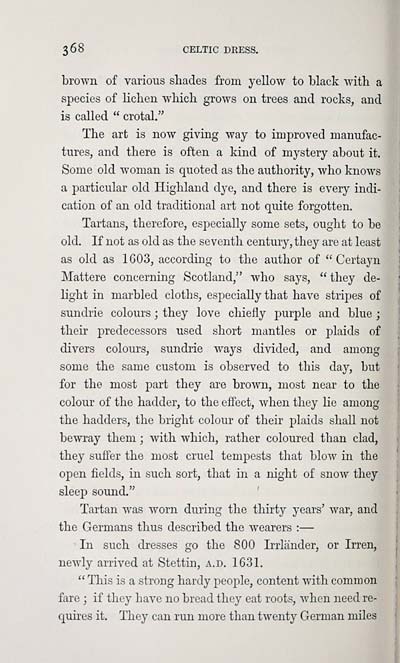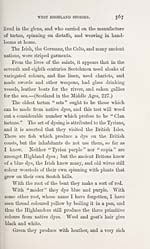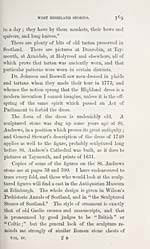Download files
Complete book:
Individual page:
Thumbnail gallery: Grid view | List view

368 CELTIC DRESS.
brown of various shades from yellow to black witb a
species of lichen which, grows on trees and rocks, and
is called " crotal."
The art is now giving way to improved manufac-
tures, and there is often a kind of mystery about it.
Some old woman is quoted as the authority, who knows
a particular old Highland dye, and there is every indi-
cation of an old traditional art not quite forgotten.
Tartans, therefore, especially some sets, ought to be
old. If not as old as the seventh century, they are at least
as old as 1603, according to the author of " Certayn
Mattere concerning Scotland," who says, "they de-
light in marbled cloths, especially that have stripes of
sundrie colours ; they love chiefly purple and blue ;
their predecessors used short mantles or plaids of
divers colours, sundrie ways divided, and among
some the same custom is observed to this day, but
for the most part they are brown, most near to the
colour of the hadder, to the efi"ect, when they he among
the hadders, the bright colour of their plaids shall not
bewi-ay them ; with which, rather coloured than clad,
they suffer the most cruel tempests that blow in the
open fields, in such sort, that in a night of snow they
sleep sound."
Tartan was worn during the thirty years' war, and
the Germans thus described the wearers : —
In such dresses go the 800 Irrlander, or Irren,
newly arrived at Stettin, a.d. 1631.
" This is a strong hardy people, content with common
fare ; if they have no bread they eat roots, when need re-
quires it. They can run more than twenty German miles
brown of various shades from yellow to black witb a
species of lichen which, grows on trees and rocks, and
is called " crotal."
The art is now giving way to improved manufac-
tures, and there is often a kind of mystery about it.
Some old woman is quoted as the authority, who knows
a particular old Highland dye, and there is every indi-
cation of an old traditional art not quite forgotten.
Tartans, therefore, especially some sets, ought to be
old. If not as old as the seventh century, they are at least
as old as 1603, according to the author of " Certayn
Mattere concerning Scotland," who says, "they de-
light in marbled cloths, especially that have stripes of
sundrie colours ; they love chiefly purple and blue ;
their predecessors used short mantles or plaids of
divers colours, sundrie ways divided, and among
some the same custom is observed to this day, but
for the most part they are brown, most near to the
colour of the hadder, to the efi"ect, when they he among
the hadders, the bright colour of their plaids shall not
bewi-ay them ; with which, rather coloured than clad,
they suffer the most cruel tempests that blow in the
open fields, in such sort, that in a night of snow they
sleep sound."
Tartan was worn during the thirty years' war, and
the Germans thus described the wearers : —
In such dresses go the 800 Irrlander, or Irren,
newly arrived at Stettin, a.d. 1631.
" This is a strong hardy people, content with common
fare ; if they have no bread they eat roots, when need re-
quires it. They can run more than twenty German miles
Set display mode to: Large image | Transcription
Images and transcriptions on this page, including medium image downloads, may be used under the Creative Commons Attribution 4.0 International Licence unless otherwise stated. ![]()
| Early Gaelic Book Collections > Blair Collection > Popular tales of the West Highlands > Volume 4 > (384) |
|---|
| Permanent URL | https://digital.nls.uk/76370298 |
|---|
| Shelfmark | Blair.176 |
|---|---|
| Attribution and copyright: |
|
| Description | Orally collected, with a translation by J.F. Campbell. |
|---|---|
| Shelfmark | Blair.173-176 |
| Additional NLS resources: | |
| Description | A selection of books from a collection of more than 500 titles, mostly on religious and literary topics. Also includes some material dealing with other Celtic languages and societies. Collection created towards the end of the 19th century by Lady Evelyn Stewart Murray. |
|---|
| Description | Selected items from five 'Special and Named Printed Collections'. Includes books in Gaelic and other Celtic languages, works about the Gaels, their languages, literature, culture and history. |
|---|

